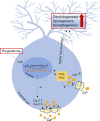Effects of progesterone on T-type-Ca2+-channel expression in Purkinje cells
- PMID: 35535898
- PMCID: PMC9120685
- DOI: 10.4103/1673-5374.339008
Effects of progesterone on T-type-Ca2+-channel expression in Purkinje cells
Abstract
Plasticity of cerebellar Purkinje cells (PC) is influenced by progesterone via the classical progesterone receptors PR-A and PR-B by stimulating dendritogenesis, spinogenesis, and synaptogenesis in these cells. Dissociated PC cultures were used to analyze progesterone effects at a molecular level on the voltage-gated T-type-Ca2+-channels Cav3.1, Cav3.2, and Cav3.3 as they helped determine neuronal plasticity by regulating Ca2+-influx in neuronal cells. The results showed direct effects of progesterone on the mRNA expression of T-type-Ca2+-channels, as well as on the protein kinases A and C being involved in downstream signaling pathways that play an important role in neuronal plasticity. For the mRNA expression studies of T-type-Ca2+-channels and protein kinases of the signaling cascade, laser microdissection and purified PC cultures of different maturation stages were used. Immunohistochemical staining was also performed to characterize the localization of T-type-Ca2+-channels in PC. Experimental progesterone treatment was performed on the purified PC culture for 24 and 48 hours. Our results show that progesterone increases the expression of Cav3.1 and Cav3.3 and associated protein kinases A and C in PC at the mRNA level within 48 hours after treatment at latest. These effects extend the current knowledge of the function of progesterone in the central nervous system and provide an explanatory approach for its influence on neuronal plasticity.
Keywords: Cav3.1; Cav3.2; Cav3.3; Purkinje cells; T-type-Ca2+-channels; neuronal plasticity; progesterone; protein kinase A; protein kinase C; rat cerebellum.
Conflict of interest statement
None
Figures






References
-
- Arcos-Montoya D, Wegman-Ostrosky T, Mejía-Pérez S, De la Fuente-Granada M, Camacho-Arroyo I, García-Carrancá A, Velasco-Velázquez MA, Manjarrez-Marmolejo J, González-Arenas A. Progesterone receptor together with PKCαexpression as prognostic factors for astrocytomas malignancy. Onco Targets Ther. 2021;14:3757–3768. - PMC - PubMed
-
- Baulieu EE. Neurosteroids: of the nervous system, by the nervous system for the nervous system. Recent Prog Horm Res. 1997;52:1–32. - PubMed
LinkOut - more resources
Full Text Sources
Research Materials
Miscellaneous

